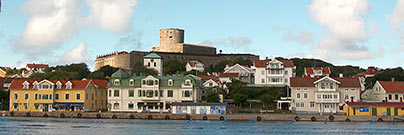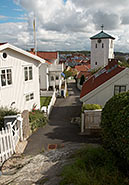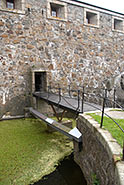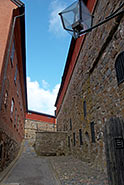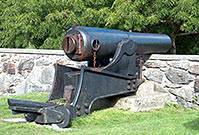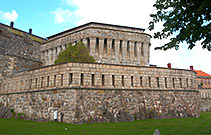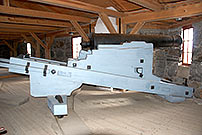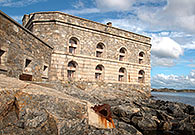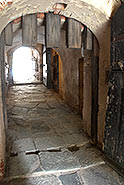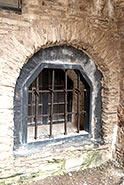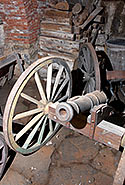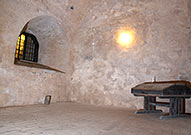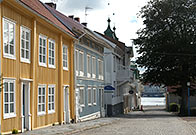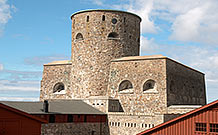History of Carlsten (Mastrand) fortress
Building if the fortress
The importance of this strategic position was aware of all - the Danes, Norwegians and, of course, the Swedes. Important points also was the fact that the island of Mastrandsen has unfreezing harbor and the prevailing western winds carried here ships coming from the continent towards Scandinavia.
In 1658 treatment of Roskilde was concluded and the province Bohuslän became Swedish. King Charles X has attended about protection of the new borders. By his orders, there were built small wooden-redoubts at the entrances to the harbor and artillery blockhouses on the islands in the bay. The one of them on the hill in the center of the Martstrandsen island called Carlsten, in honor of the King. Soon General Johan Warneschold was ordered to rebuild the redoubt Carlsten in the stone, which was done in 1667. New strengthening represents a square in plan building with the square observation tower.
Famous Swedish fortifier Eric Dahlberg was in charge in the fortress after that. In it the end of 1660s height of the towers and walls was increased, the front yard added, two additional artillery blockhouse were built, also as a gun and mortar batteries. New wall surrounding the Big yard was erected in 1690s, and in 1694 it was decorated with the impressive King's gate with a drawbridge over a moat.
Construction of the fortress continued until the mid-19th century, height and thickness of the walls were increased, Southern Dungeon and two auxiliary (flanking) battery were built, a powder magazine with enhanced bomb protection, the new outer wall, wooden barracks in the Big yard were added, until finally in 1860 Stockholm received a report that the construction of a fortress was completed.
In the first half of the 19th century Carlsten considered as one of the most powerful fortresses in Northern Europe. Artillery park included up to 80 heavy guns, 10 heavy mortars and a big variety of lighter weapons, including field guns.
In 1878, the Swedish Fortification Committee of the General Staff, considered the usefulness of the Carlsten for the defense of the country, came to the conclusion that there is no more use in this fortress. New steam vessels are no longer dependent on the wind and the importance of Marstrand like harbour decreased significantly, and the eternal enemies of Sweden - Danes have become much calmer.
In 1882, the garrison left the fortress and its weapons were transferred to Karlsborg and Vaxholm. Then, during the 30 years since 1907 School of Marine apprentices was in the fortress. Also various branches of military educational institutions were in Carlsten till 1990s.
In 1937 Carlsten fortress was opened for civilian visitors, and in 1993 the Ministry of Defence handed over the fortress to the Department of State Property (Statens fastighetsverk).
War history
In 1659, new fortifications Marstrand for the first time participated in repelling the attack Norwegian troops.
During the war with Denmark in the 1675-1679 (War of Skåne or Skanske Krig) July 23, 1677 the fortress was handed her commander Sinclair to Norwegian governor Gyullenlёve, which with 5 thousand troops and hundred of guns seized Marstrand and besieged Carlsten. The siege lasted more than 3 weeks, besieged suffered badly from the continuous bombardment, but more from thirst.
The second time Carlsten was captured during the Great Northern War by the Danish-Norwegian admiral Tordenskjold, which in April 1719 arrived in Gothenburg area. Commandant of the fortress Dankwart (Dankwart) had 388 man in the fortress. Danes easily captured the city, but could not seize Carlsten .
Then Tordensheld started 'psychological warfare' against the Swedes, spreading rumors and sending anonymous letters about his superiority in forces and allegedly arriving reinforcement of 20 thousand from Copenhagen. In the end, 26 July 1719 Dankwart surrendered the fortress. He was courtmartialed and hanged in Bohuslotte three months later. In June 1720 Carlsten fortress was returned to the Swedes.
In April 1811 commandant von Carl von Dobeln declared a state of siege in the fortress due to the fact that in the Kattegat entered the English fleet. King of Sweden at the time was Bernadotte, a former marshal of Napoleon and Sweden at that time was on the side of France. However, after a month the English fleet went home because everything was settled by diplomatic means.
Prison history
Almost since its foundation and until the middle of the 19th century Carlsten fortress was also a hight security prison. So called 'Marstrand's works' were considered at that time in Sweden, as one of the most severe punishments.
There were three types of prisoners: criminals - murderers, robbers, thieves, rapists, etc., which were used in the construction of the fortress; important state criminals - opposition politicians, spies, traitors; as well as the so-called 'confession' convicted.
About confession convicts - if the court does not have enough evidence to convict, a man was imprisoned in the fortress, until he confesses in his crime to garrison priest. Some of them were in the cells of Carlsten up top 20 years or more.
The prison existed here until 1854, when all its prisoners were transferred to Elfsborg because the construction of the fortress was finished, and there were no need for forced labor.
Impressions
It is very beautiful fortress in a wonderful location near to a cozy and quite wooden Swedish town of Marstrand. Spa in the full sense of the word.
The fortress itself leaves a great impression. It has a neat and elaborate construction. There are virtually no 'dead zones' of fire. It is pleasant to walk on here in the fortress and notice, where you can be shoot and what from.
The fortress itself simply breathes with an antiquity. Plenty authentic details everywhere - door locks, latches, electrical equipment and other furniture end of the last century or more of the ancient.
There are heaps of various old things of 19-18 centuries in the fortress vaults. And there are a lot of it out there! You can come to touch it. Some places just do not have electric light yet.
Excellent views from a top of walls, and especially from the tower. You need to reserve all the day to carefully inspect the fortress, the city and of course, take a walk around the island. Officer barracks in the fortress are converted into a hotel and you can spend the night here and it will be nice night, but expensive too.
Land forts and fortress:
Bip Castle Gatchina Ivangorod Izborsk Kexholm Kirillov Monastery Koporye Novgorod Pechorskiy Monastery Peter&Paul Fortress Porkhov Pskov Schlisselburg Staraya Ladoga Tikhvin Vyborg Hameenlinna Hamina Kastelholm Kymenlinna Lappaenranta Raseborg Castle Savonlinna Tavetti Turku Visby Fredrikstadt Fredriksten Hegra Fort Hoytorp Fort Arensburg Narva Tallinn Antipatris Caesarea Jerusalem Latrun Fort Masada
Sea forts and fortresses:
Alexander Fort Ino Fort Krasnaya Gorka Fort Kronstadt: Kotlin isl. Kronstadt: North Forts Kronstadt: South Forts Trongsund Hanko Svartholm Sveaborg Marstrand Siaro Fort Vaxholm Oscarsborg
Artillery batteries and individual guns:
Coastal Artillery Hemso Fort
Fortified areas and defensive lines:
Karelian Fortified Area (KaUR) KrUR Leningrad Mannerheim Line Nevsky Bridgehead VT Line Harparskog Line Salpa Line Gothland
Russian
S e a r c h All news

